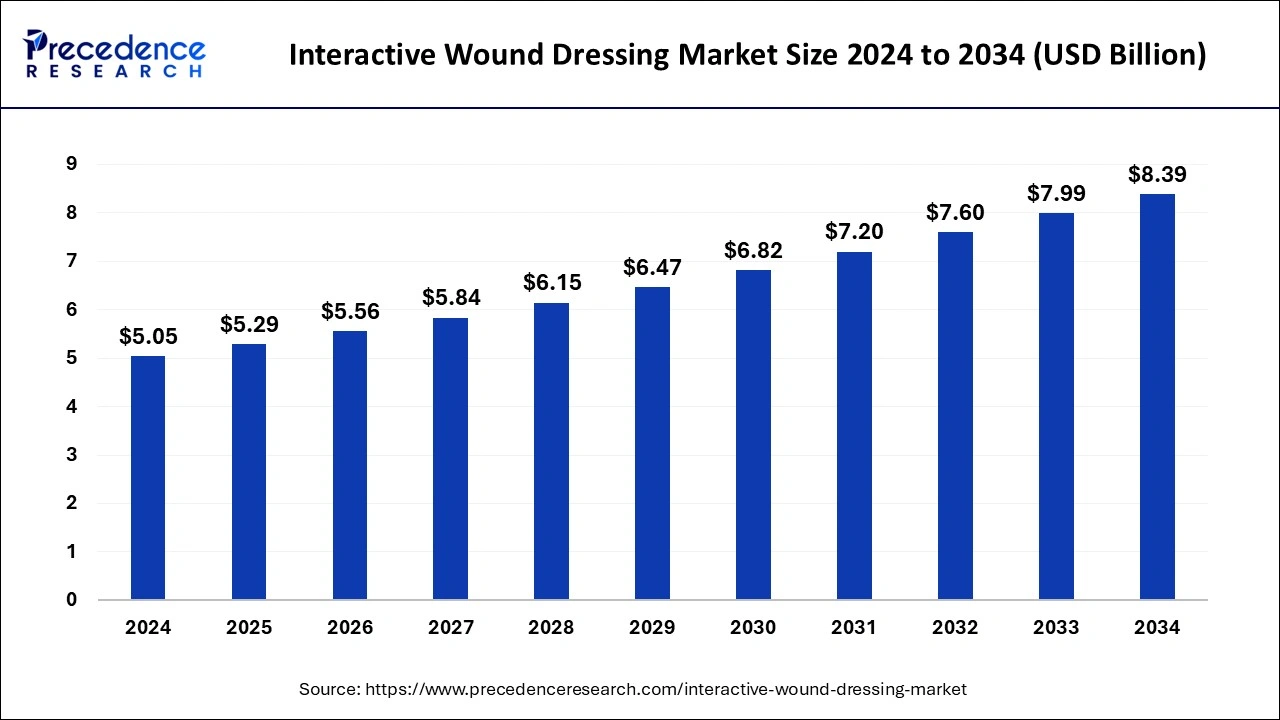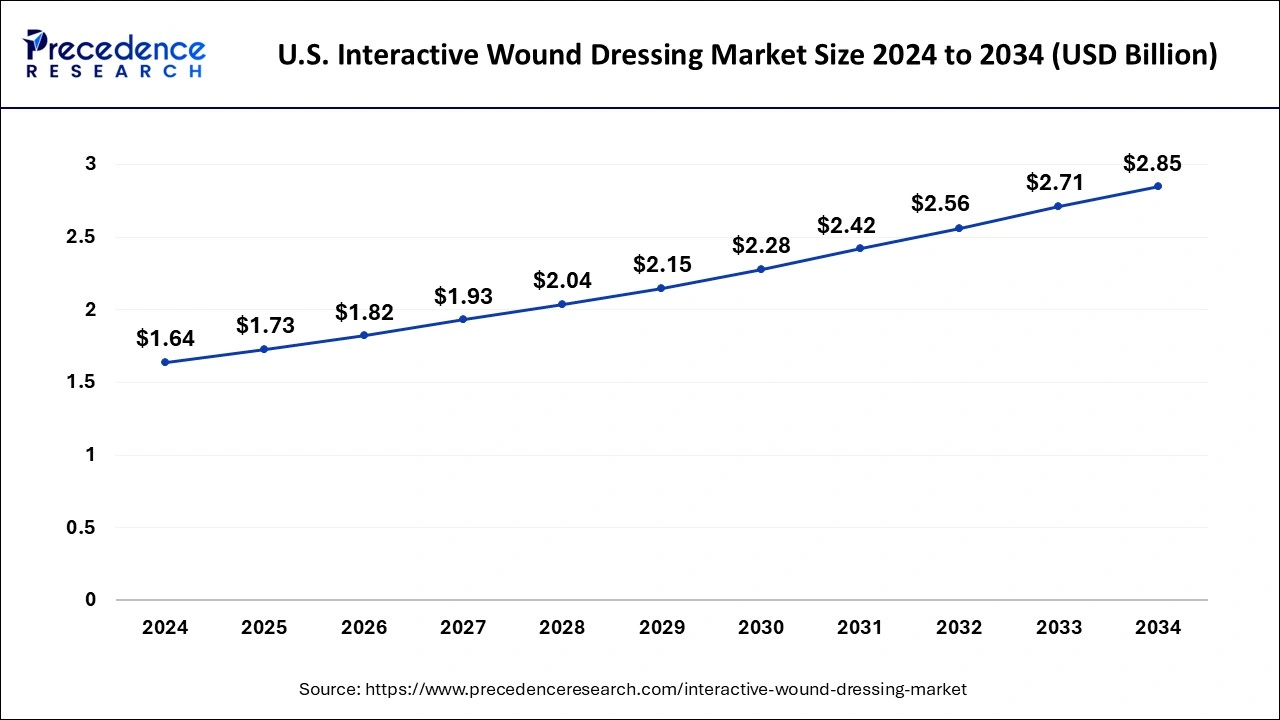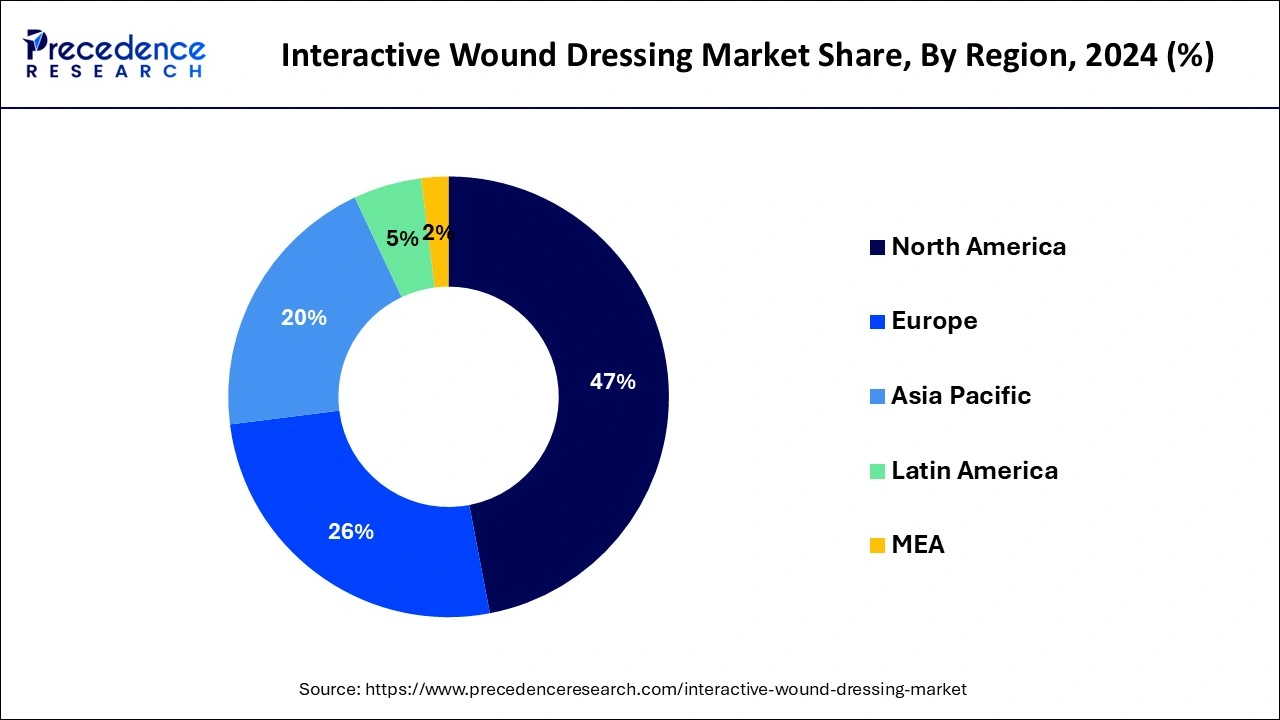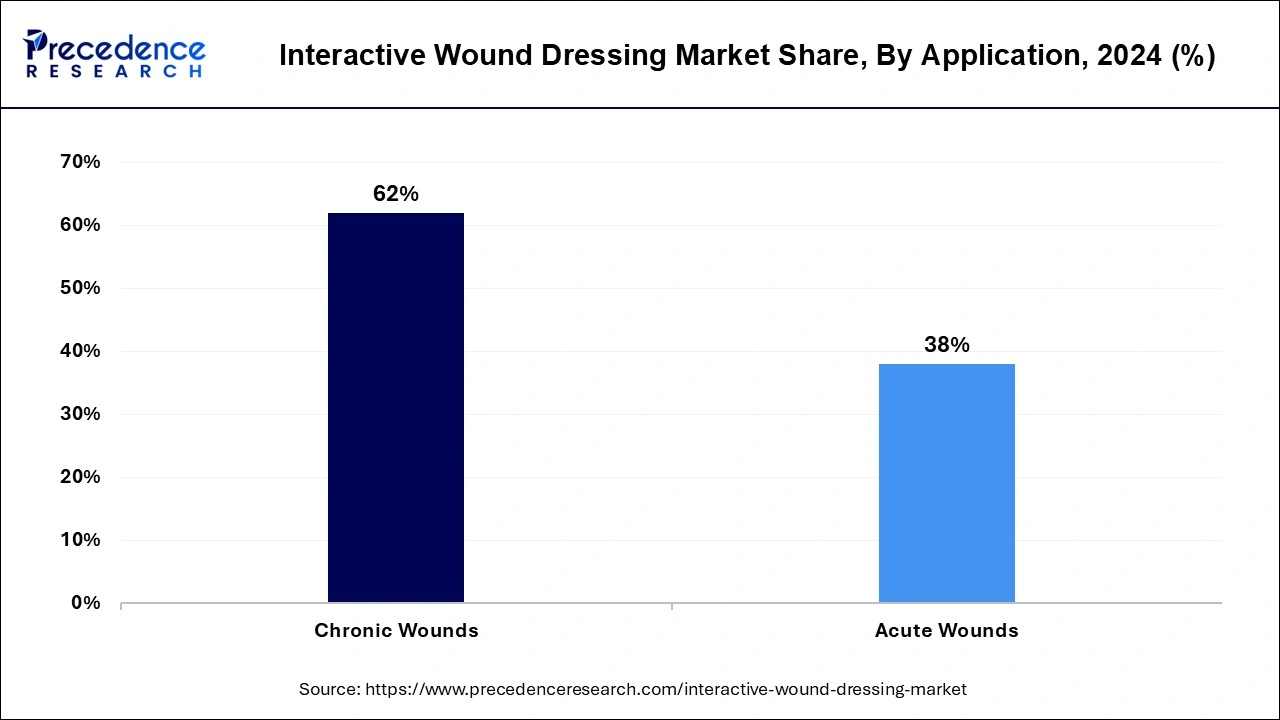Interactive Wound Dressing Market Size and Forecast 2025 to 2034
The global interactive wound dressing market size size was estimated at USD 5.05 billion in 2024 and is predicted to increase from USD 5.29 billion in 2025 to approximately USD 8.39 billion by 2034, expanding at a CAGR of 5.21% from 2025 to 2034.

Interactive Wound Dressing MarketKey Takeaways
- North America captured the largest market share of 47% in 2024.
- Asia-Pacific is predicted to grow at the fastest CAGR between 2025 and 2034.
- By Product, the semi-permeable film generated the highest market share of 44% in 2024.
- By Product, the semi-permeable foam dressings segment is expected to expand at the fastest CAGR of 7.8% between 2024 and 2033.
- By Application, the chronic wounds segment contributed more than 62% of revenue share in 2024.
- By Application, the acute wounds segment is anticipated to grow at the fastest rate over the projected period.
- By End-use, the new hospital segment had the biggest market share of 51.8% in 2024.
- By End-use, the homecare segment is anticipated to expand at the fastest rate over the projected period.
U.S.Interactive Wound Dressing Market and Growth 2025 to 2034
The U.S. interactive wound dressing market size accounted for USD 1.64 billion in 2024 and is estimated to reach around USD 2.85 billion by 2034, growing at a CAGR of 5.68% from 2025 to 2034.

North America has held the largest revenue share 47% in 2024. In North America, the interactive wound dressing market is witnessing several trends. The region is characterized by a growing aging population, leading to a higher incidence of chronic wounds, thereby driving the demand for advanced wound care solutions. Technological advancements and a strong emphasis on patient-centric care have led to the adoption of interactive dressings with remote monitoring capabilities. Additionally, the well-established healthcare infrastructure and proactive regulatory environment contribute to the rapid integration of these innovative wound care solutions, making North America a significant player in the market.
Asia-Pacific is estimated to observe the fastest expansion In the Asia-Pacific region, the interactive wound dressing market is experiencing notable trends. Growing healthcare expenditure, particularly in countries like China and India, is driving the demand for advanced wound care solutions. Moreover, an aging population, coupled with an increasing prevalence of chronic wounds, fuels the adoption of interactive dressings. Healthcare infrastructure development and a surge in telemedicine practices have also heightened the appeal of remote monitoring-enabled interactive dressings in the region. These trends underscore the evolving landscape of wound care, emphasizing patient-centric and technologically advanced solutions in Asia-Pacific.

Market Overview
- The interactive wound dressing market encompasses medical products designed for advanced wound care, featuring interactive elements that facilitate healing. These dressings are equipped with technologies such as sensors, microelectronics, or hydrogels that actively monitor and manage wounds. They create a conducive environment for tissue regeneration, control infection, and promote healing.
- This market is characterized by innovation in wound care technologies, a focus on patient comfort, and the integration of smart features for real-time monitoring and feedback to healthcare providers, improving the overall wound management process.
Interactive Wound Dressing MarketGrowth Factors
- The interactive wound dressing market centers on advanced wound care solutions designed to actively facilitate wound healing. These dressings incorporate innovative technologies, such as sensors, microelectronics, or hydrogels, to create an interactive environment for wound management.
- The market is driven by a commitment to improving patient outcomes, reducing complications, and revolutionizing the conventional wound care approach. Several notable trends and growth drivers are shaping the interactive wound dressing market, including the increasing prevalence of chronic wounds, such as diabetic ulcers and pressure sores, is driving the demand for advanced wound care solutions.
- The integration of smart features, including real-time monitoring and feedback mechanisms, empowers healthcare providers to tailor treatment regimens more effectively. Additionally, the aging population and a rise in surgical procedures contribute to the need for advanced wound care options.
- The interactive wound dressing market faces certain challenges, including the need for cost-effective solutions to ensure widespread adoption. Ensuring the reliability and durability of interactive dressing components is critical, as is navigating regulatory and compliance hurdles.
- Moreover, the integration of technology into wound dressings requires careful consideration of patient comfort and ease of use. In this dynamic landscape, numerous business opportunities exist within the interactive wound dressing market. Companies can invest in research and development to create innovative dressing designs that offer enhanced healing capabilities and reduced complications.
- Collaboration with healthcare institutions to conduct clinical trials and gather real-world data can drive product development and market adoption. The market also offers opportunities to expand into emerging economies, where wound care infrastructure is evolving. Moreover, partnerships with telemedicine providers and healthcare networks can integrate interactive wound care into remote patient monitoring, a growing trend in modern healthcare.
Market Scope
| Report Coverage | Details |
| Growth Rate from 2025 to 2034 | CAGR of 5.21% |
| Market Size in 2025 | USD 5.29 Billion |
| Market Size by 2034 | USD 8.39 Billion |
| Largest Market | North America |
| Base Year | 2024 |
| Forecast Period | 2025 to 2034 |
| Segments Covered | By Product, By Application, and By End-use |
| Regions Covered | North America, Europe, Asia-Pacific, Latin America, and Middle East & Africa |
Market Dynamics
Driver
Rising prevalence of chronic wounds and surgical site infections (SSIs)
The rising prevalence of chronic wounds, such as diabetic ulcers and pressure sores, significantly propels the demand for interactive wound dressing. These persistent wounds require specialized and innovative wound care solutions, like interactive dressings, which are equipped with advanced technologies to expedite healing and reduce complications. As chronic wounds become more common, healthcare providers increasingly turn to interactive dressings to enhance patient outcomes, making them a crucial component in addressing the healthcare needs of individuals with these challenging and prevalent conditions.
Moreover, Surgical Site Infections (SSIs) significantly boost the demand for interactive wound dressing. These infections pose serious risks to patients undergoing surgical procedures, leading healthcare providers to seek advanced wound care solutions. Interactive wound dressings with infection-monitoring capabilities create a sterile environment, reducing the likelihood of SSIs. This heightened focus on infection prevention and patient safety drives the adoption of interactive dressings, making them an integral component of modern surgical practices and underscoring their role in meeting healthcare needs effectively.
Restraints
Higher cost and complexity
The Interactive Wound Dressing Market faces notable restraints in the form of higher cost and complexity, which can limit its market demand significantly. Firstly, the incorporation of sophisticated technologies, such as sensors and microelectronics, into these dressings increases their production costs. This elevated cost can deter healthcare providers and facilities, particularly in budget-constrained settings, from adopting these advanced wound care solutions. Moreover, the complexity associated with interactive dressings can hinder their widespread adoption.
Healthcare professionals may require specialized training to use and manage these dressings effectively. This training adds both time and resource overheads to healthcare institutions, potentially making traditional wound care options more appealing. Additionally, the higher upfront expenses can pose challenges for healthcare budgets, making it difficult to justify the adoption of interactive dressings, especially when more cost-effective alternatives are available. To mitigate these restraints, manufacturers and stakeholders in the interactive wound dressing industry need to focus on cost-effectiveness, simplicity, and clear benefits in terms of patient outcomes. Demonstrating the long-term cost savings and improved healing rates associated with interactive dressings can help overcome these barriers and drive wider adoption in the healthcare industry.
Opportunities
Technological advancements and remote monitoring
The integration of cutting-edge technologies within wound dressings, such as microelectronics, sensors, and smart materials, has transformed wound care. These innovations enable real-time monitoring of wound conditions, including temperature, moisture levels, and bacterial presence. Such data empowers healthcare providers with timely insights, facilitating early intervention and personalized treatment plans.
Furthermore, advanced wound dressings equipped with microelectronics can administer therapies like electrical stimulation or drug delivery directly to the wound site, promoting faster healing. Patients benefit from reduced discomfort and shorter healing times, fostering increased adoption.
Moreover, Remote monitoring capabilities have become increasingly vital in modern healthcare, especially during the COVID-19 pandemic. Interactive wound dressings with remote monitoring features enable healthcare professionals to track wound progress and intervene promptly, even from a distance. This capability aligns with the growing trend of telemedicine and remote patient care, enhancing patient outcomes and reducing the need for frequent in-person visits. Patients in remote or underserved areas also benefit, as they gain access to specialized wound care expertise without geographical constraints. The combination of technological advancements and remote monitoring not only improves patient comfort and care but also drives the market's demand by offering efficient, patient-centric wound management solutions.
Product Insights
According to the Product, the semi-permeable film has held 44% revenue share in 2024. Semi-permeable film dressings in the interactive wound dressing market are transparent, adhesive dressings that create a moist environment for wound healing while allowing oxygen and moisture vapor exchange. These dressings promote healing in superficial wounds and protect against infection. Recent trends in this segment include advancements in film dressing materials to enhance breathability and adherence. Additionally, manufacturers are focusing on developing designs that cater to various wound shapes and sizes, improving ease of application and patient comfort. The semi-permeable film dressing segment continues to evolve to meet diverse wound care needs efficiently.
The Semi-permeable foam dressings segment is anticipated to expand at a significant CAGR of 7.8% during the projected period Semi-permeable foam dressings are a type of interactive wound dressing designed to create a moist environment while allowing the exchange of gases. They are composed of hydrophilic foam layers with a semi-permeable outer layer. These dressings are highly absorbent and promote optimal wound healing conditions by maintaining a balanced moisture level and facilitating exudate management. A notable trend in the interactive wound dressing market is the increasing adoption of semi-permeable foam dressings due to their effectiveness in managing exudate and promoting granulation tissue formation. These dressings offer enhanced patient comfort and are suitable for a wide range of wounds, including chronic ulcers and surgical incisions. Additionally, advancements in semi-permeable foam dressing materials and designs are driving their popularity, offering improved breathability and exudate handling capabilities, further contributing to their demand in wound care management.
Application Insights
Based on the application, the Chronic wounds segment is anticipated to hold the largest market share of 62% in 2024. Chronic wounds, such as diabetic ulcers and pressure sores, refer to non-healing or slow-healing wounds that persist over an extended period. In the interactive wound dressing market, a notable trend is the increasing focus on chronic wound management. Interactive dressings equipped with advanced technologies like sensors and microelectronics offer real-time monitoring and targeted therapies, effectively addressing the complexities of chronic wounds. This trend underscores the market's commitment to improving patient outcomes and reducing the burden of chronic wound care, which is particularly significant given the aging population and rising prevalence of diabetes.

On the other hand, the Acute wounds segment is projected to grow at the fastest rate over the projected period. Acute wounds are sudden injuries that damage the skin and underlying tissue, typically resulting from accidents, surgical procedures, or burns. In the interactive wound dressing market, a trend is emerging where interactive dressings are increasingly employed for acute wound management. These dressings, equipped with advanced features like real-time monitoring and infection control, are aiding in the accelerated healing of acute wounds. This trend reflects a growing recognition of the benefits of interactive dressings in improving outcomes and reducing complications in the treatment of acute injuries.
End-use Insights
In 2023, the new hospital segment had the highest market share of 51.8% on the basis of end use. Hospitals are a primary end-user of interactive wound dressings, leveraging these advanced solutions for comprehensive wound care. These dressings provide real-time wound monitoring and treatment capabilities, facilitating efficient care within hospital settings. A prominent trend in hospitals is the integration of interactive dressings with electronic health records (EHR) systems, streamlining data management and enhancing patient care coordination. Additionally, hospitals are increasingly adopting telemedicine solutions, leveraging remote monitoring features of interactive dressings to extend wound care expertise to patients beyond the hospital walls, improving patient outcomes and reducing healthcare costs.
The homecare is anticipated to expand at the fastest rate over the projected period. In the interactive wound dressing market, "homecare" refers to the utilization of advanced wound dressings in a home setting. A notable trend is the increasing preference for home-based wound care due to its convenience and cost-effectiveness. Interactive dressings with user-friendly interfaces enable patients or caregivers to monitor wounds easily. The COVID-19 pandemic accelerated this trend as patients sought to minimize hospital visits. Homecare in the interactive wound dressing market reflects the shift towards patient-centered care and the empowerment of individuals to actively participate in their wound healing process while staying in the comfort of their homes.
Interactive Wound Dressing Market Companies
- Smith & Nephew plc
- Mölnlycke Health Care AB
- 3M Company
- ConvaTec Group PLC
- Acelity L.P. Inc. (a subsidiary of 3M)
- Coloplast A/S
- Medline Industries, Inc.
- B. Braun Melsungen AG
- Paul Hartmann AG
- Medtronic plc
- Integra LifeSciences Holdings Corporation
- Lohmann & Rauscher GmbH & Co. KG
- Gentell, Inc.
- DermaRite Industries, LLC
- Advancis Medical Ltd.
Recent Developments
- In 2020, Portea Medical has partnered with ConvaTec to expand its healthcare services, offering specialized ostomy care and wound management solutions to patients. This collaboration aims to provide comprehensive and high-quality care for individuals with ostomy and wound care needs.
- In 2019, 3M has successfully completed the acquisition of Acelity, Inc., bolstering its position in the advanced and surgical wound care segment. This strategic move enhances 3M's portfolio and capabilities in providing innovative wound care solutions to a broader range of patients.
Segments Covered in the Report
By Product
- Semi-permeable films dressing
- Semi-permeable foams dressing
- Hydrogel dressing
By Application
- Chronic Wounds
- Acute Wounds
By End-use
- Hospitals
- Outpatient Facilities
- Home care
- Research & manufacturing
By Geography
- North America
- Europe
- Asia-Pacific
- Latin America
- Middle East and Africa
For inquiries regarding discounts, bulk purchases, or customization requests, please contact us at sales@precedenceresearch.com
Frequently Asked Questions
Ask For Sample
No cookie-cutter, only authentic analysis – take the 1st step to become a Precedence Research client
 sales@precedenceresearch.com
sales@precedenceresearch.com
 +1 804-441-9344
+1 804-441-9344